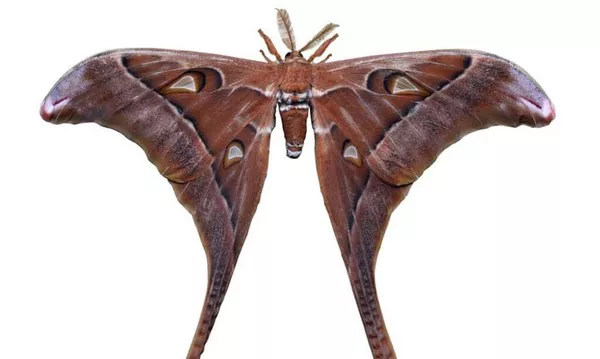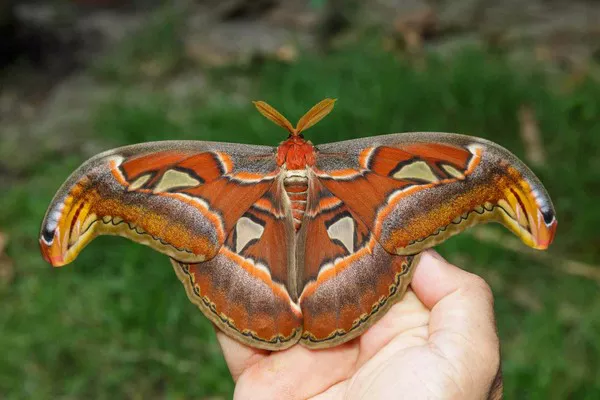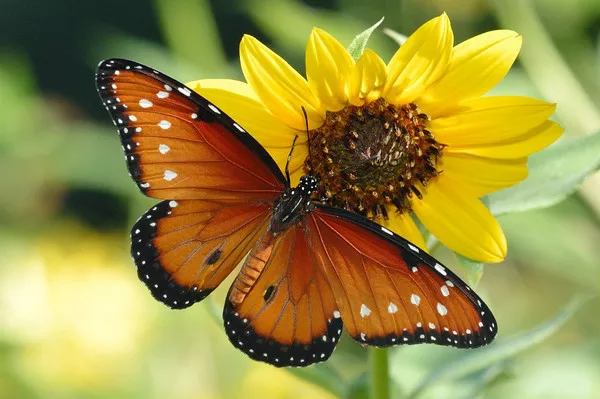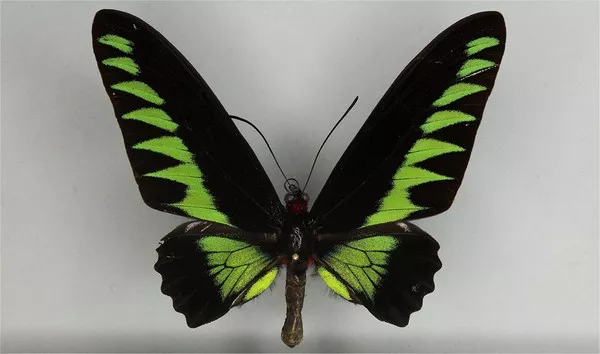Butterflies, with their delicate wings and vibrant colors, are among nature’s most enchanting creatures. While many are known for their small size, some species stand out for their impressive wingspan and majestic presence. This article explores the 10 largest butterflies in the world, showcasing their size, habitats, unique characteristics, and the conservation challenges they face.
10 Largest Butterflies in the World
1. Queen Alexandra’s Birdwing (Ornithoptera alexandrae)

Overview: Named after Queen Alexandra of England, Queen Alexandra’s Birdwing is the largest butterfly species in the world in terms of wingspan. Native to Papua New Guinea, these butterflies are renowned for their striking blue-green wings with yellow markings and a wingspan that can reach up to 11 inches (28 cm).
Habitat: Found in rainforests, particularly in lowland areas where their larval host plants, Aristolochia species, grow abundantly.
Unique Characteristics: Besides their impressive size, Queen Alexandra’s Birdwings are known for their slow and majestic flight. They exhibit sexual dimorphism, with females generally larger and more colorful than males.
Conservation Status: Endangered due to habitat destruction, logging, and collection for the illegal wildlife trade. Conservation efforts include habitat preservation, captive breeding programs, and community education.
See Also: The 10 Largest Bees in the World
2. Goliath Birdwing (Ornithoptera goliath)

Overview: The Goliath Birdwing, native to the rainforests of Papua New Guinea and the Solomon Islands, is another giant among butterflies. It is named after the biblical figure Goliath due to its impressive size, with a wingspan that can reach up to 11 inches (28 cm).
Habitat: Found in tropical rainforests, often near rivers or streams where their larval host plants, Aristolochia species, thrive.
Unique Characteristics: Like other birdwing butterflies, the Goliath Birdwing displays sexual dimorphism, with females being larger and more colorful than males. Their wings are predominantly black with green and yellow markings.
Conservation Status: Vulnerable due to habitat loss from logging, agricultural expansion, and climate change. Conservation efforts focus on habitat protection, sustainable forestry practices, and raising awareness about their importance.
3. Hercules Moth (Coscinocera hercules)

Overview: Although technically a moth, the Hercules Moth deserves mention for its impressive size and beauty. It is native to the rainforests of New Guinea and northern Australia, with a wingspan that can exceed 11 inches (28 cm), making it one of the largest moths in the world.
Habitat: Found in tropical rainforests, where it depends on its larval host plants, primarily trees in the family Myrtaceae.
Unique Characteristics: The Hercules Moth is known for its intricate patterns and colors, with wings that range from reddish-brown to orange and white. Males have feathery antennae used to detect pheromones released by females.
Conservation Status: Faces threats from habitat destruction due to logging and land conversion. Conservation efforts include habitat preservation, monitoring populations, and studying its life cycle to inform conservation strategies.
4. Atlas Moth (Attacus atlas)

Overview: The Atlas Moth, native to tropical and subtropical forests of Southeast Asia, is one of the largest moth species in the world. While not a butterfly, its impressive size and distinctive appearance warrant inclusion.
Habitat: Found in rainforests and secondary forests where its larval host plants, including citrus and other trees, are abundant.
Unique Characteristics: Known for its wingspan that can reach up to 10 inches (25 cm) and distinctive wing patterns resembling snake heads. The Atlas Moth has a short lifespan as an adult, focusing its energy on reproduction.
Conservation Status: Generally stable due to its wide distribution, although local populations may be threatened by habitat loss and collection for the silk industry. Conservation efforts include sustainable forest management and protection of key habitats.
5. South American Queen (Troides rhadamantus)

Overview: The South American Queen, also known as the King Swallowtail or Golden Birdwing, is a large butterfly species native to South America, particularly in the Amazon rainforest regions.
Habitat: Found in lowland rainforests where its larval host plants, particularly species in the Aristolochia genus, are abundant.
Unique Characteristics: Known for its wingspan that can reach up to 8 inches (20 cm) and striking golden-yellow coloration with black and white markings. The males are more vividly colored compared to females.
Conservation Status: Faces threats from habitat destruction due to logging, agricultural expansion, and infrastructure development. Conservation efforts focus on protected area management, habitat restoration, and community engagement.
6. Rajah Brooke’s Birdwing (Trogonoptera brookiana)

Overview: Rajah Brooke’s Birdwing is a spectacular butterfly species native to the rainforests of Southeast Asia, including Malaysia and Indonesia. It is named after Sir James Brooke, the first White Rajah of Sarawak.
Habitat: Found in primary and secondary rainforests where its larval host plants, primarily species in the genus Aristolochia, grow.
Unique Characteristics: Known for its large wingspan of up to 7 inches (18 cm) and iridescent green and black coloration. Males have prominent green markings on their forewings.
Conservation Status: Vulnerable due to habitat loss from deforestation, agricultural expansion, and illegal collection. Conservation efforts include habitat protection, captive breeding programs, and sustainable development initiatives.
7. Wallace’s Golden Birdwing (Ornithoptera croesus)

Overview: Wallace’s Golden Birdwing, named after the naturalist Alfred Russel Wallace, is a majestic butterfly species found in the rainforests of Papua New Guinea and Indonesia.
Habitat: Prefers primary and secondary rainforests where its larval host plants, particularly species in the Aristolochia genus, are abundant.
Unique Characteristics: Known for its large size with a wingspan that can exceed 6 inches (15 cm). Males exhibit striking golden-yellow coloration with black borders, while females are generally larger and have broader wings.
Conservation Status: Faces threats from habitat destruction due to logging, mining, and agricultural activities. Conservation efforts focus on habitat preservation, monitoring populations, and public education.
8. Homerus Swallowtail (Papilio homerus)

Overview: The Homerus Swallowtail, native to Jamaica, is the largest butterfly species in the Americas and one of the largest swallowtail butterflies in the world.
Habitat: Found in the moist limestone forests of Jamaica, where its larval host plants, particularly species in the Rutaceae family, are prevalent.
Unique Characteristics: Known for its impressive wingspan of up to 6 inches (15 cm) and striking black and yellow coloration with blue and red spots on the hindwings. Males and females exhibit sexual dimorphism in size and coloration.
Conservation Status: Critically endangered due to habitat loss from deforestation, agriculture, and urban development. Conservation efforts include habitat restoration, captive breeding programs, and community engagement.
9. Giant Swallowtail (Papilio cresphontes)

Overview: The Giant Swallowtail, native to North and South America, is one of the largest swallowtail butterfly species globally.
Habitat: Found in a variety of habitats, including forests, gardens, and urban areas, where its larval host plants, particularly citrus trees, are cultivated.
Unique Characteristics: Known for its large wingspan of up to 6 inches (15 cm) and distinctive yellow and black coloration. It has a wide distribution across the Americas, adapting to diverse ecological conditions.
Conservation Status: Generally stable due to its adaptable nature and wide distribution. However, local populations may be threatened by habitat loss and pesticide use. Conservation efforts focus on sustainable agriculture and urban planning.
10. Priam’s Birdwing (Ornithoptera priamus)

Overview: Priam’s Birdwing, found in Australia, Papua New Guinea, and nearby islands, is one of the largest birdwing butterfly species.
Habitat: Occurs in rainforests and lowland areas where its larval host plants, particularly species in the genus Pararistolochia, grow abundantly.
Unique Characteristics: Known for its impressive wingspan of up to 6 inches (15 cm) and vibrant green and black coloration with yellow markings. Males and females exhibit sexual dimorphism, with females generally larger and more brightly colored.
Conservation Status: Faces threats from habitat destruction, illegal collection, and climate change impacts. Conservation efforts include habitat protection, monitoring populations, and public awareness campaigns.
See Also: Top 10 Biggest Flying Insects in the World
Conclusion
These 10 largest butterflies in the world showcase the incredible diversity and beauty of these winged creatures. From the tropical rainforests of Papua New Guinea to the limestone forests of Jamaica, these butterflies have adapted to diverse habitats and ecological niches. However, many face threats from habitat destruction, climate change, and illegal trade, highlighting the need for concerted conservation efforts. By protecting their habitats, promoting sustainable practices, and raising awareness, we can ensure these magnificent butterflies continue to grace our skies for generations to come.
You Might Be Interested In:


























